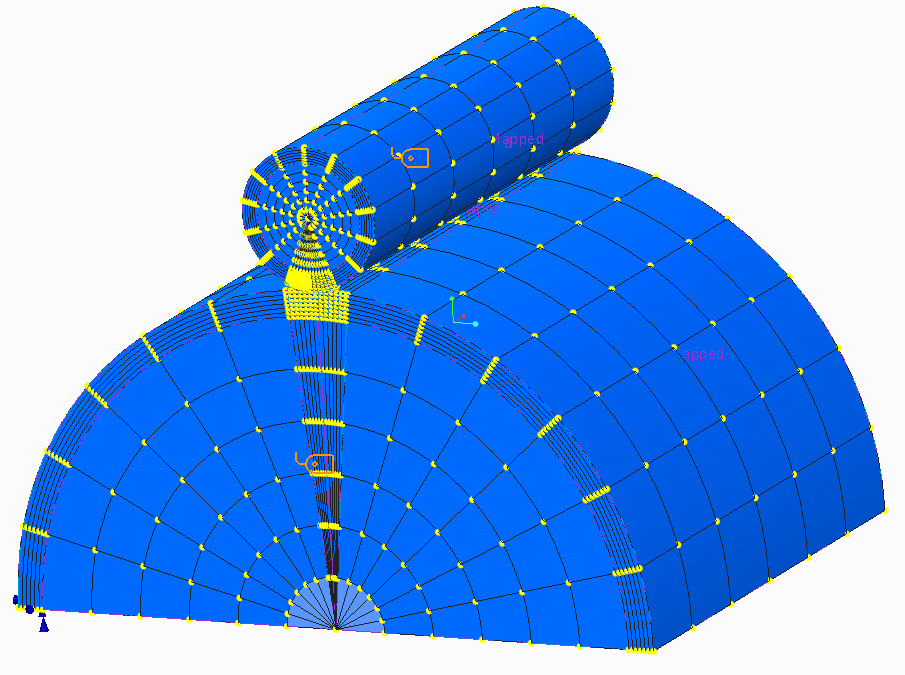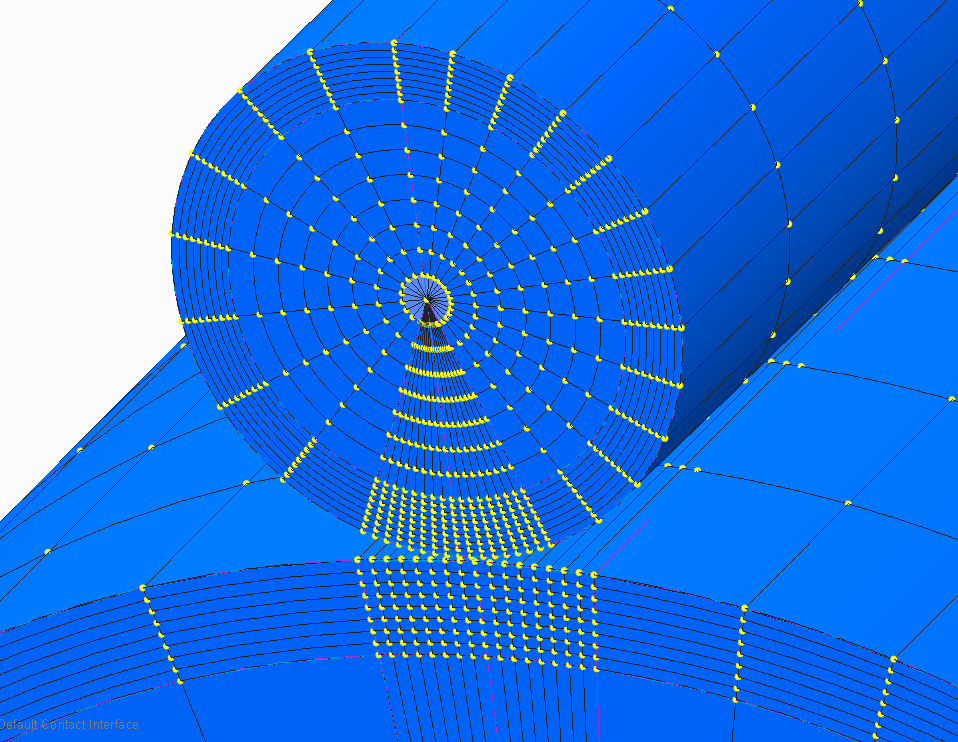Community Tip - You can subscribe to a forum, label or individual post and receive email notifications when someone posts a new topic or reply. Learn more! X
- Community
- Creo+ and Creo Parametric
- Analysis
- Re: Mapped Mesh on Fillet
- Subscribe to RSS Feed
- Mark Topic as New
- Mark Topic as Read
- Float this Topic for Current User
- Bookmark
- Subscribe
- Mute
- Printer Friendly Page
Mapped Mesh on Fillet
- Mark as New
- Bookmark
- Subscribe
- Mute
- Subscribe to RSS Feed
- Permalink
- Notify Moderator
Mapped Mesh on Fillet
I was wondering if anyone can tell me how to create a mapped mesh on the geometry highlighted in yellow. I used to have just a cylinder with no fillets. I used brick elements on the oter tube and wedge elements on the inner cylinder. This ran nicely. This is a hyper-elastic/contact analysis. Now I added fillets and I have no idea how to create wedge elements in the radius portion. I was thinking wedge elements in the radius portion and brick in the rest. Can anyone help?
This thread is inactive and closed by the PTC Community Management Team. If you would like to provide a reply and re-open this thread, please notify the moderator and reference the thread. You may also use "Start a topic" button to ask a new question. Please be sure to include what version of the PTC product you are using so another community member knowledgeable about your version may be able to assist.
Solved! Go to Solution.
- Labels:
-
General
Accepted Solutions
- Mark as New
- Bookmark
- Subscribe
- Mute
- Subscribe to RSS Feed
- Permalink
- Notify Moderator
Paul and Charles,
I was able to create a mapped mesh of the geometry (or atleast on a piece of geometry I created to match yours); you can view the pdf here. This was done entirely in integrated mode.
That being said, the mapped meshing feature in Simulate is rather frustrating at times (to say the least).
- Mark as New
- Bookmark
- Subscribe
- Mute
- Subscribe to RSS Feed
- Permalink
- Notify Moderator
Hi Paul,
I have reviewed the image of your model. Your assumption is correct....for the fillet region you should be creating a WEDGE mesh.
The available selection types for creating mesh regions are datum point, vertex, edge and 3 sided surfaces (4 sided in case of BRICKS).
In the event that such references do not exist, you can always select surface/edge locations.
The mesh region points are connected along common edge.
Note: If edge does not exist, then common surface is tried and joined along it. If both of them do not exist, the points are joined via straight line.
Would you be able to share your model? I would like to give this a try.
Hope this information helps.
Regards,
Mark
- Mark as New
- Bookmark
- Subscribe
- Mute
- Subscribe to RSS Feed
- Permalink
- Notify Moderator
I need to see if it is ok to upload my clients model (which I think is doubtful). In the meantime. If you created a tube with an OD of .362" and an ID of .263" then added a .010" radius to the id on either end this would be representative of the outer piece. The inner piece is just a cylinder with a diameter of .260". Both outer and inner are 1.0" long. The assembly would just be the both pieces together as shown in the above image. I am simplifying the geometry here but this will show the problem I am having. I just don't know quite how to make the selection for the wedge elements on the radius portion. Then beyond that, I am hoping to fill the rest with bricks....
- Mark as New
- Bookmark
- Subscribe
- Mute
- Subscribe to RSS Feed
- Permalink
- Notify Moderator
Oh....I forgot. I cut the assembly in half so I could apply a symmetry constraint.....
- Mark as New
- Bookmark
- Subscribe
- Mute
- Subscribe to RSS Feed
- Permalink
- Notify Moderator
Hi Mark,
I was frustrated by similar simple geometry a while a go.
I made some notes; attached.
I must be on the wrong wavelength.
Thanks
Charles
- Mark as New
- Bookmark
- Subscribe
- Mute
- Subscribe to RSS Feed
- Permalink
- Notify Moderator
Paul and Charles,
I was able to create a mapped mesh of the geometry (or atleast on a piece of geometry I created to match yours); you can view the pdf here. This was done entirely in integrated mode.
That being said, the mapped meshing feature in Simulate is rather frustrating at times (to say the least).
- Mark as New
- Bookmark
- Subscribe
- Mute
- Subscribe to RSS Feed
- Permalink
- Notify Moderator
Shaun,
That certainly answers Paul's question,
I used your method and then with 90 deg volume regions (which effectively gives the same vertices to pick). Keeping the subtended angle of any mapped region <=90deg seems key if 'self intersecting' error is to be avoided.
Using only a 10deg portion of cylinder I expected to be able to get the vertex selection method to work (using field points to find the internal corner of the wedge). I could not and got errors : 'self intersecting' and 'mesh region is not fully contained in the model' and 'included angle between the edges is out of range' depending on what order I did things.
The point about the old Rasna 'revolve' delete shells (y/n) was that is was really really simple and intuituve.
Successsful Mapped meshing tactics are just not obvious (if possible) and will put users off the functionality.
- Mark as New
- Bookmark
- Subscribe
- Mute
- Subscribe to RSS Feed
- Permalink
- Notify Moderator
Hello, Charles,
It's just a story, as you have referred to Rasna, for those who would not have known, even under DOS.
Cordially.
Denis.
- Mark as New
- Bookmark
- Subscribe
- Mute
- Subscribe to RSS Feed
- Permalink
- Notify Moderator
Re-Hello, Charles,
Oops, sorry, too fast, I forgot the document.
Cordially.
Denis.
- Mark as New
- Bookmark
- Subscribe
- Mute
- Subscribe to RSS Feed
- Permalink
- Notify Moderator
Denis,
Terrifying. That was a quarter of a century ago.
Regards
Charles
- Mark as New
- Bookmark
- Subscribe
- Mute
- Subscribe to RSS Feed
- Permalink
- Notify Moderator
Thanks! I got this to work using your technique. Funny, I was going to try breaking this up as well, but it would have taken me forever to come up with your method! Thanks again!
-Paul
- Mark as New
- Bookmark
- Subscribe
- Mute
- Subscribe to RSS Feed
- Permalink
- Notify Moderator
Hi all,
Sorry for the delay in responding.
Thank you Shaun for providing the steps for creating the mapped mesh for this particular part. As you can see building the framework via a sketched feature will help in defining the volume regions which can then be used for defining mapped mesh control options.
You need to keep in mind, as Charles mentioned, keeping the subtended angle of any mapped region <=90deg will avoid the 'self intersecting' error.
I have uploaded the sample model which leverages the methods Shaun referenced.
If you have further questions, please comment or send me an email at -.
Regards,
Mark
- Mark as New
- Bookmark
- Subscribe
- Mute
- Subscribe to RSS Feed
- Permalink
- Notify Moderator
Thanks all - this looks interesting and I'm about to give it a try.
One question for now: where is the 'mapped mesh control' in WF4 or WF5?
- Mark as New
- Bookmark
- Subscribe
- Mute
- Subscribe to RSS Feed
- Permalink
- Notify Moderator
Jonathan,
Mapped meshes arrived with Creo 1.0.
- Mark as New
- Bookmark
- Subscribe
- Mute
- Subscribe to RSS Feed
- Permalink
- Notify Moderator
Ah, thanks. From the RASNA references I'd assumed it was something that had been there all along, just hidden somewhere...
- Mark as New
- Bookmark
- Subscribe
- Mute
- Subscribe to RSS Feed
- Permalink
- Notify Moderator
I'm trying to mesh something similar to the example. I've got bricks working for the three rectangular areas, but for the fillet 'triangle' (using wedges) I get errors such as "Mesh region is not fully contained in the model geometry." What am I doing wrong?
(If it makes a difference, I'm trying to mesh just one segment (<90°) of the cylinder...)
Thanks!
- Mark as New
- Bookmark
- Subscribe
- Mute
- Subscribe to RSS Feed
- Permalink
- Notify Moderator
- Mark as New
- Bookmark
- Subscribe
- Mute
- Subscribe to RSS Feed
- Permalink
- Notify Moderator
Hi Jonathan,
After building the sketch feature to break up the geometry to create the volume regions, I was able to create the mapped mesh.

You can also control the mapped mesh subdivisions easily. I have increased them in this image.

I will zip the model up and send it back. You will need to reapply your loads and constraints as I removed them when creating the volume regions.
The challenge is to create the sketched feature to breakup the geometry in local sections for the volume regions. You also want to make sure the mapped mesh nodes all line up.
Hope this helps.
Thanks,
Mark
- Mark as New
- Bookmark
- Subscribe
- Mute
- Subscribe to RSS Feed
- Permalink
- Notify Moderator
Hi Mark,
Thanks again for your help. However, in your model you've extruded elements along the length of the parts; I want to revolve them around the axis, so that I can model the end fillets (which you've 'removed') as well as a non-parallel "diameter".
Sometimes I can make this work, and often I can simply select two end surfaces to mesh between which works very well. However, sometimes it refuses to select the second surface and if I pick vertices instead I get the message "Selected references do not form a valid mesh region."
In one case it even allowed me to mesh a volume at one end of the part, yet refused to recognise the identical volume at the other end...
What's causing this error message?
- Mark as New
- Bookmark
- Subscribe
- Mute
- Subscribe to RSS Feed
- Permalink
- Notify Moderator
Hi Jonathan,
In most cases I would try to simplify the model....which I did in this case.
I suggest a quick call to discuss the process.
Please send me an e-mail (-) and we can setup a time.
Regards,
mark
- Mark as New
- Bookmark
- Subscribe
- Mute
- Subscribe to RSS Feed
- Permalink
- Notify Moderator
Hi Paul,
I was digging into the issue related to keeping the subtended angle of any mapped region <=90deg to avoid the 'self intersecting' error with the Simulate development team yesterday.
Technically, we support the angle of mapped regions to 180 degreed. Would you please open a ticket with technical support and raise this issue? While I know you may not be able to provide the actual model, I ask you to submit your test model.
This way, we will address the issue and have it linked directly to you.
Regards,
Mark





